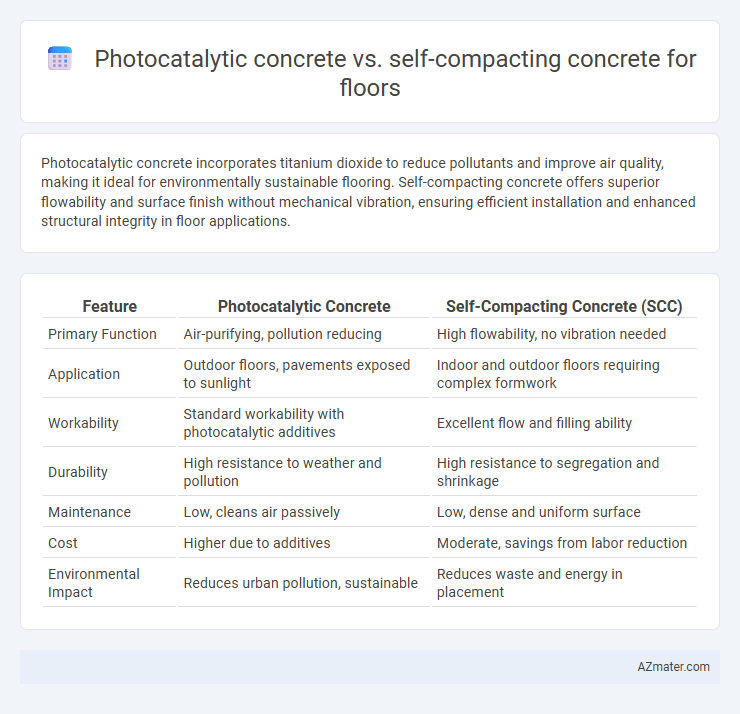Photocatalytic concrete incorporates titanium dioxide to reduce pollutants and improve air quality, making it ideal for environmentally sustainable flooring. Self-compacting concrete offers superior flowability and surface finish without mechanical vibration, ensuring efficient installation and enhanced structural integrity in floor applications.
Table of Comparison
| Feature | Photocatalytic Concrete | Self-Compacting Concrete (SCC) |
|---|---|---|
| Primary Function | Air-purifying, pollution reducing | High flowability, no vibration needed |
| Application | Outdoor floors, pavements exposed to sunlight | Indoor and outdoor floors requiring complex formwork |
| Workability | Standard workability with photocatalytic additives | Excellent flow and filling ability |
| Durability | High resistance to weather and pollution | High resistance to segregation and shrinkage |
| Maintenance | Low, cleans air passively | Low, dense and uniform surface |
| Cost | Higher due to additives | Moderate, savings from labor reduction |
| Environmental Impact | Reduces urban pollution, sustainable | Reduces waste and energy in placement |
Introduction to Photocatalytic Concrete and Self-Compacting Concrete
Photocatalytic concrete incorporates titanium dioxide nanoparticles that activate under UV light to break down pollutants, providing self-cleaning and air-purifying properties ideal for urban flooring applications. Self-compacting concrete (SCC) is a highly fluid mixture designed to flow under its own weight, achieving high strength and excellent surface smoothness without mechanical vibration, commonly used for complex floor slab installations. Both materials offer distinct advantages for floor construction, with photocatalytic concrete enhancing environmental sustainability while SCC ensures superior placement and structural integrity.
Key Properties of Photocatalytic Concrete
Photocatalytic concrete incorporates titanium dioxide nanoparticles that enable it to break down organic pollutants and reduce air pollution through a light-activated process, enhancing urban air quality. Its key properties include high photocatalytic efficiency, self-cleaning ability, and improved durability due to resistance against surface pollution and dirt accumulation. Unlike self-compacting concrete, which prioritizes flowability and ease of placement, photocatalytic concrete focuses on environmental benefits and surface maintenance for floor applications.
Essential Characteristics of Self-Compacting Concrete
Self-compacting concrete (SCC) exhibits essential characteristics such as high flowability, enabling it to fill complex molds and densely reinforced floor structures without mechanical vibration. Its superior segregation resistance and stability ensure uniform surface finish and durability under heavy foot traffic conditions. Compared to photocatalytic concrete, SCC prioritizes ease of placement and structural integrity, while photocatalytic concrete emphasizes air-purifying properties through titanium dioxide additives.
Comparative Strength and Durability
Photocatalytic concrete exhibits enhanced durability due to its ability to reduce surface pollutants and resist environmental degradation, contributing to longer-lasting floor surfaces. Self-compacting concrete offers superior strength and uniformity through its highly flowable mix, which minimizes voids and increases compressive strength compared to traditional concrete. While photocatalytic concrete excels in maintaining surface integrity and environmental benefits, self-compacting concrete provides higher mechanical strength and improved structural performance for floor applications.
Floor Installation Challenges and Solutions
Photocatalytic concrete for floors offers self-cleaning properties by breaking down pollutants, but its installation requires precise curing conditions and protection from contaminants to maintain photocatalytic efficiency. Self-compacting concrete (SCC) simplifies floor installation through high flowability and reduced vibration needs, addressing challenges like congested reinforcement and uneven surfaces. Both types demand tailored admixtures and strict quality control to ensure durability and surface performance in flooring applications.
Environmental Impact and Sustainability
Photocatalytic concrete incorporates titanium dioxide, enabling it to break down pollutants and improve urban air quality, significantly reducing environmental impact. Self-compacting concrete, characterized by its high flowability and reduced need for mechanical vibration, minimizes energy consumption on construction sites and decreases waste. Both materials promote sustainability, with photocatalytic concrete enhancing air purification and self-compacting concrete improving resource efficiency and durability in floor applications.
Maintenance and Long-Term Performance
Photocatalytic concrete offers reduced maintenance by actively breaking down pollutants and organic matter on its surface, resulting in cleaner floors and enhanced air quality over time. Self-compacting concrete provides superior durability and uniformity, minimizing repair needs due to its dense microstructure and resistance to cracking under heavy load conditions. Long-term performance favors photocatalytic concrete in urban environments requiring pollution control, while self-compacting concrete excels in industrial settings demanding structural integrity and minimal surface defects.
Cost Analysis and Economic Considerations
Photocatalytic concrete integrates titanium dioxide, enhancing air purification but incurs higher material and maintenance costs compared to self-compacting concrete (SCC), which reduces labor expenses due to its ease of placement and compaction. SCC's optimized mix design lowers construction time and machinery needs, resulting in overall cost savings for large floor projects despite lacking the environmental benefits of photocatalytic options. Economic considerations favor SCC in budget-sensitive applications, while photocatalytic concrete justifies its premium through potential long-term urban air quality improvements and associated health cost reductions.
Best Applications for Each Concrete Type in Floor Construction
Photocatalytic concrete excels in outdoor flooring applications such as sidewalks, plazas, and parking lots by actively reducing air pollutants and maintaining cleaner surfaces through its titanium dioxide component. Self-compacting concrete is ideal for indoor flooring and complex formworks in commercial and residential buildings where rapid placement, high fluidity, and superior surface finish without mechanical vibration are critical. Choosing photocatalytic concrete enhances environmental sustainability in exposed flooring, while self-compacting concrete optimizes efficiency and quality in constrained or architecturally intricate floor construction.
Future Trends in Innovative Concrete Technologies
Photocatalytic concrete incorporates titanium dioxide nanoparticles to reduce air pollution and enhance surface cleanliness through sunlight-driven reactions, presenting a sustainable solution for urban flooring. Self-compacting concrete, with its high flowability and ability to fill complex molds without vibration, improves efficiency and quality in construction projects, particularly in large-scale flooring systems. Future trends emphasize hybrid materials combining photocatalytic properties with self-compacting formulations to optimize durability, environmental benefits, and ease of installation in innovative concrete flooring technologies.

Infographic: Photocatalytic concrete vs Self-compacting concrete for Floor
 azmater.com
azmater.com